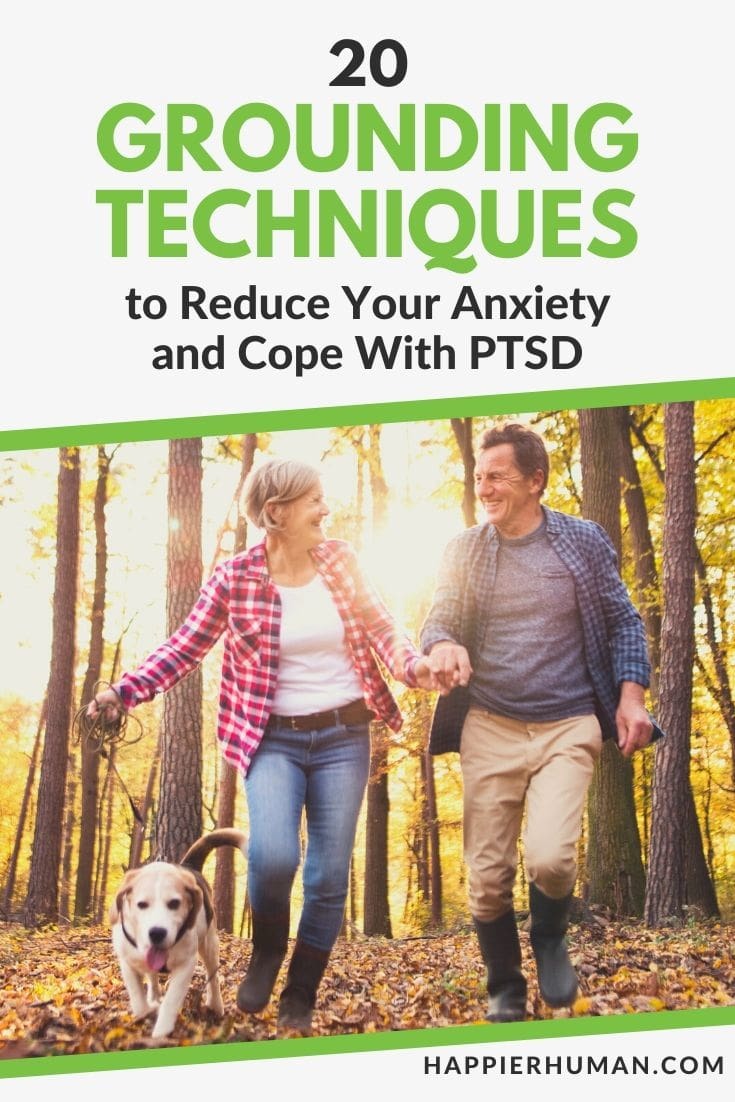We all know what anxiety feels like — that dreadful sensation of panic, worry, and restlessness that sucks the joy out of life.
There are times when anxiety is so intense and overwhelming that you tend to lose touch with reality. In other words, you fixate on whatever worry-filled thoughts are racing through your head.
When you’re dealing with panic attacks or severe anxiety, it almost feels like you’re entirely disconnected from the world around you.
Fortunately, there’s a simple strategy that allows you to get back in touch with reality and keep your anxious thoughts under control.
It’s called grounding, and numerous experts recommend it as an effective strategy for dealing with anxiety.
But to understand how grounding techniques work (and why it’s such a useful anxiety management tool), first we need to look at how anxiety impacts our perception, thinking, and mood.
The Dark Side of Anxiety
Ask any person who’s dealing with a form of anxiety, and they will tell you how annoying and exhausting it is to feel under pressure most of the day.
It’s hard to focus on the bright side of things when your mind keeps worrying about a future that hasn’t yet materialized.
If you wish to cultivate a fulfilling life, you need to start by implementing healthier habits, and Happier Human is the book that will help you achieve precisely that.
Although we generally perceive anxiety as an unpleasant state, the truth is, each one of us had experienced it at some point in our lives.
In fact, anxiety is part of our emotional spectrum, which means getting rid of it entirely is out of the question.
As baffling as it may sound, you need anxiety to survive and thrive in our ever-changing, ever-growing society
Think about it! Anxiety is what prompts you to evaluate risks and make informed decisions; it’s why you look twice before you cross a busy street; it’s what keeps you away from physical and emotional harm.
In short, it’s a pretty handy survival mechanism.
Unfortunately, there’s also a ‘dark’ side to anxiety. In other words, there are times when this mechanism can work against you.
For example, when you’re agoraphobic, so you avoid taking the subway to work. Or when you wish to speak in front of an audience, but you get dizzy and nauseous just by thinking about it.
“Worry never robs tomorrow of its sorrow; it only saps today of its joy.” – Leo F. Buscaglia
It seems too little anxiety makes you careless and reckless, while too much can “paralyze” you.
Let’s take PTSD, for example. This form of anxiety disorder occurs as a result of a traumatic event. If you have a car accident, chances are anxiety will keep you from getting behind the wheel.
In theory, anxiety does precisely what it’s supposed to do – keep you out of harm’s way. In this example, it prevents you from driving, therefore, eliminating the possibility of another car accident.
And when you try to go against it, you might be surprised to discover how intense anxiety can get.
As people who struggle with PTSD will tell you, exposing yourself to something that has caused you pain and trauma in the past can result in panic attacks.
That means your heart starts beating fast, you take desperate gasps of air, you feel disconnected from everything around you, and all you can think about is running away.
So, how can we bypass such an intense reaction? How can we overcome anxiety, achieve post-traumatic growth, and enjoy the life we want?
The answer is – GROUNDING.
What is Grounding?
Grounding is a form of mindfulness, a technique that quickly reconnects you with the ‘here and now.’
When you’re dealing with anxiety, dissociation, or flashbacks, you tend to remain fixated on all sorts of images, thoughts, and memories that keep playing inside your head.
As a result, you begin to lose touch with your surroundings; your senses are “disabled” by the anxiety that takes over your body and mind.

And this is where grounding comes into play, bringing you back into the present moment. This technique helps you re-establish a connection with your surroundings, with the space you find yourself in at that moment.
To ground yourself in the present moment, you will need to use all your five senses – sight, sound, smell, touch, and taste. Your basic senses are the means through which you interact with the outside world.
By smelling the flowers on your kitchen table, tasting a delicious cookie, or listening to the sound of cars passing by, your mind will slowly let go of any obsessive and intrusive images.
Because it helps you focus on your environment – instead of the worry-filled thoughts that are racing through your head – grounding is an effective way to distract yourself and avoid a panic attack.
But let’s take a step-by-step look at how grounding reduces anxiety.
How Do Grounding Techniques Help Reduce Anxiety?
Let’s say you’ve had an unpleasant experience with public speaking. Perhaps you were humiliated by your teacher in front of the whole class. Or maybe you forgot your lines in the middle of a school play, and you left the stage feeling ashamed.
Now you work at a sales company, and you must deliver product presentations in front of potential clients. The stakes are high, and you don’t want them to leave disappointed or confused.
However, the minute you walk in the room, your palms get sweaty, you begin to feel slightly dizzy, and everything seems ‘unreal.’ The more you focus on your anxious thoughts, the more disconnected you feel from everything that’s going on around you.
It’s tough to deliver a fluent presentation and create a connection with your audience when anxiety keeps you trapped in a never-ending circle of catastrophic scenarios.
And that’s why you need to re-establish a connection with your surroundings; to leave worries in the back of your mind and ground yourself in the ‘here and now.’
Using your five senses, you can anchor yourself in the present moment by focusing on sensations that are hard to ignore.
For instance, the touch of your pen slowly gliding on a piece of paper, the sound of people talking on their phones or typing on their computers, the smell of fresh coffee.
The more connected you are with your surroundings, the less likely you are to lose yourself in anxious thoughts and end up having a nervous breakdown. Furthermore, grounding techniques can also reduce the likelihood of flashbacks and dissociation.
Before you try these strategies, keep in mind that grounding is a profoundly personal practice. In other words, what works for some might not work for others. And that’s why it’s crucial to experiment with several techniques (and senses) before you find the ones that work best for you.
But don’t worry, because I’ve prepared a list of 20 grounding techniques that you can experiment with.
20 Grounding Techniques You Can Try Right Now
1. Eat a cookie
This grounding technique may sound ridiculously simple. But is can be effective when you begin to spiral out of control from anxiety or PTSD.
Eating a cookie – or whatever snack you find delicious – is an excellent way to ground yourself in the ‘here and now.’ This simple action can stimulate your taste, smell, and touch.

Focus on the sweet taste, the crunchy texture, and the pleasant smell of a cookie. That way, you can distract yourself from those catastrophic scenarios and unpleasant flashbacks that are going through your head.
2. Look at the sky
Sometimes, all it takes to ground yourself in the present moment is to look at the sky. Next time you feel anxiety bubbling up on the surface of your mind, take a seat somewhere on a bench and look at the sky for a couple of minutes.
Focus on the color, the shape of the clouds, perhaps an airplane moving slowly on the canvas of the sky, leaving a white trail behind it.
3. Walk barefoot on grass
Walking barefoot on grass can be an incredible sensory experience. The pleasant feel of soft grass on the soles of your feet can bring you back in the ‘here and now’ in no time.
If you find yourself in the park or on your front yard lawn, take a moment to walk barefoot on grass. It will distract you from all those worry-filled thoughts and help you enjoy some well-deserved calm.
4. Drink a glass of water (slowly)
Just like enjoying a delicious cookie, drinking a glass of water allows you to focus on the ‘here and now.’
Whenever panic takes over, and you feel like you’re slowly losing touch with reality, pour yourself a glass of water and pay attention to the sensations that you experience while drinking it.
And the best part is that you can practice this grounding technique anytime and anywhere.
5. Fold a paper airplane
Remember the paper airplanes you used to make when you were a kid? It turns out this activity can serve as an excellent grounding strategy.
Not only that folding a paper airplane distracts you from anxious thoughts, flashbacks, and feelings of dissociation, but it also allows you to remain anchored in the present moment.
So, next time you feel anxious and disconnected from reality, pick up a piece of paper, and start folding an airplane. You can even throw it across the room and watch it fly.
6. Listen to music
If you feel like noticing random sound around you is boring, perhaps some music can get you out of your head and into the present moment.
Furthermore, experts agree that listening to your favorite music can affect your mood and level of happiness.
Next time you feel anxious or panicked, search for your favorite tunes and hit play. It will put you in a better mood and distract you from all those panic-inducing thoughts and images.
Looking for your song ideas? Check out our favorites:
- 25 Best Songs About Dealing with Strong Emotions
- 25 Best Songs About Growing Up & Coming of Age
- 21 Gratitude Songs About Being More Thankful
7. Read the names of stores around you
When you feel like anxiety has taken control over your thoughts, and all you can think about is how badly you’re going to fail at today’s presentation, you can distract yourself by reading the names of stores you see around you.

If you’re indoors, you can read the titles of the books or music albums you have in your bookcase. For a more profound sensory experience, try touching each book or music album while reading the title out loud.
8. Smell the flowers
“Stop and smell the flowers” is actually great piece of advice on using a grounding technique to gain control of your out of control thinking.
When was the last time you stopped to smell the flowers? Or the smell of fresh pastry coming from the store that you pass by every day on your way to work. Or even the earthy smell of freshly cut grass.
The smells that we come by each day can elicit amazing sensory experiences that ground us in the present moment.
If you find yourself in a place that generates anxiety and panic, stop for a moment, take a deep breath through your nose, and notice the smells around you.
9. Touch the desk
A quick way to connect yourself with your surroundings is through your tactile sense. In other words, each object around you acts as an anchor that can keep you from losing touch with reality.
One look around the room, and you will find numerous objects of different textures, sizes, and shapes that you can experience with a simple touch.
Whenever you feel lost in worries and concerns, pick up an object from your desk and focus on its features (shape, size, texture, function). It will put you back in touch with your surroundings.
10. Count cars
Just like reading titles off a shelf, counting the cars that are passing in front of your house or office can distract you from anxiety, panic, and flashbacks.
You don’t even have to count each one of them. The mere act of paying attention to the movement of cars, their color, speed, shape, and other features is a useful grounding strategy.
11. Hold an ice cube
We know for a fact that our nervous system is sensitive to any significant change in temperature. This allows us to regulate our body temperature and achieve a state of comfort.
But did you know that you can use the same system to distract yourself from flashbacks, panic-inducing thoughts, and feelings of dissociation?
Try holding an ice cube in your palm and focus on that sensation of cold and slight numbness on the surface of your skin. It will stop you from ‘drowning’ in catastrophic scenarios and keep you anchored in the ‘here and now.’
12. Move around the room
The act of moving can generate a whole array of physical sensations. The contact between your feet and the floor, the movement of your arms, the sound of your shoes – all these sensations are a reminder that you are here, in the present moment.
Instead of letting yourself be carried away by panic and painful memories, you can get up and take a few steps while focusing on your body’s movements. A simple two-minute walkabout can do wonders.
13. Take a deep breath
Sometimes, all it takes to ground yourself in the present moment are a few deep breaths.
Next time you feel like you’ve lost touch with reality because your mind is overwhelmed by flashbacks, panic, and anxiety, take a deep breath and notice how the air fills your lungs.

Exhale and focus on how your body ‘softens’ and relaxes; it almost feels like the weight of the world has been lifted from your shoulders. And once the body begins to relax, the mind will soon follow.
14. Describe your surroundings
Take a close look around you and notice the space you find yourself in at that moment. Imagine you’re an extraterrestrial being on its first contact with the human civilization.
What do you see around you? What objects, colors, shapes, and textures do you see? What are the purposes of all these objects surrounding you?
Create a mental description of each object you see that will anchor you in the present moment.
15. Wash your hands
Just like walking, washing your hands employs the use of various movements and sensations.
For example, you can focus on the feel of water on your hands, the temperature, the touch of one hand washing the other, and the smell of soap. By noticing these sensations, you can reconnect with the space around you.
However, try not to use it too much as it may turn into compulsive behavior.
16. Listen to the sounds around you
No matter where you work or live, you will always have background sound. But since background sounds are there 24/7, we grow so accustomed to the environment that we eventually stop noticing them.
If you feel overwhelmed by panic and dissociation, all you need to do is notice the sounds around you. It could be anything from the distant sound of traffic to the more proximal sound of a squeaky chair.
17. Pet your cat or dog
Most experts believe owning a pet can have a significantly positive impact on your health and wellbeing.
During moments of stress and anxiety, petting your dog or cat, watching your goldfish swim across the tank, or feeding your parrot creates a sense of comfort and helps you focus on the ‘here and now.’
A pet can be a great source of joy and a reliable ally when you feel like everything’s falling apart.
18. Play with a ball
Playing with a ball – or any other activity that involves movement – can be a powerful distractor for when you feel entirely overwhelmed by panic and flashbacks.
Bouncing a ball against the floor or simply throwing it up and down keeps you focused on the present moment by stimulating your visual and tactile senses.
Furthermore, when it comes to stress relief, squeezing a stress ball is one of the oldest tricks in the book.
19. Talk to someone
Talking to someone is perhaps the best way to get out of your head and reconnect with your surroundings. Furthermore, by opening a conversation with someone available to listen, you can also benefit from an empathetic ear or a shoulder to cry on.

Long story short, taking is not just an activity that distracts you from those catastrophic scenarios but also a profoundly therapeutic act.
20. Describe an object you see
If describing your surroundings feels too distracting, perhaps you can try to focus on one object at a time.
Next time you feel disconnected from reality, pick a random object, hold it in your hand, and describe it in as much detail as possible. From shape and size to texture, color, and function, make sure you cover as many features as possible.
For a more profound sensory experience, you can even name its features out loud.
Final Thoughts on Grounding Techniques
When you’re dealing with anxiety or PTSD, the quest for happiness and joy can quickly turn into an obstacle course where your primary goal is to avoid discomfort and emotional pain.
Since life is unpredictable, sooner or later, you will have to face situations or contexts in which you don’t feel comfortable. And that’s when panic kicks in, pulling you away from a distressing reality.
Fortunately, grounding techniques can help you face these situations without getting lost in panic-inducing thoughts and images that prompt you to give up.
The more connected you are with your reality – the more you anchor yourself in the ‘here and now’ – the better you can control anxiety.
From a broader perspective, the way you choose to handle your occasional moments of anxiety and flashbacks will influence your sense of happiness and well-being.
For more helpful tips on how to cultivate a happy and fulfilling life, check out Happier Human. This book contains 52 science-backed habits that will guide you in your quest for the life you wish to achieve.
And if you're looking for more ideas, check out these blog posts:
- 50 Quick Things to Do When You're Feeling Down
- 16 Practical Ways to Love Yourself More
- 57 Simple Pleasures That Fill Your Day with Happiness
Finally, if you want a simple way to reduce your stress and anxiety, then try writing these 35 mindfulness journaling prompts to live more in the present moment.


Alexander Draghici is a licensed Clinical Psychologist, CBT practitioner, and content writer for various mental health websites. His work focuses mainly on strategies designed to help people manage and prevent two of the most common emotional problems – anxiety and depression.

